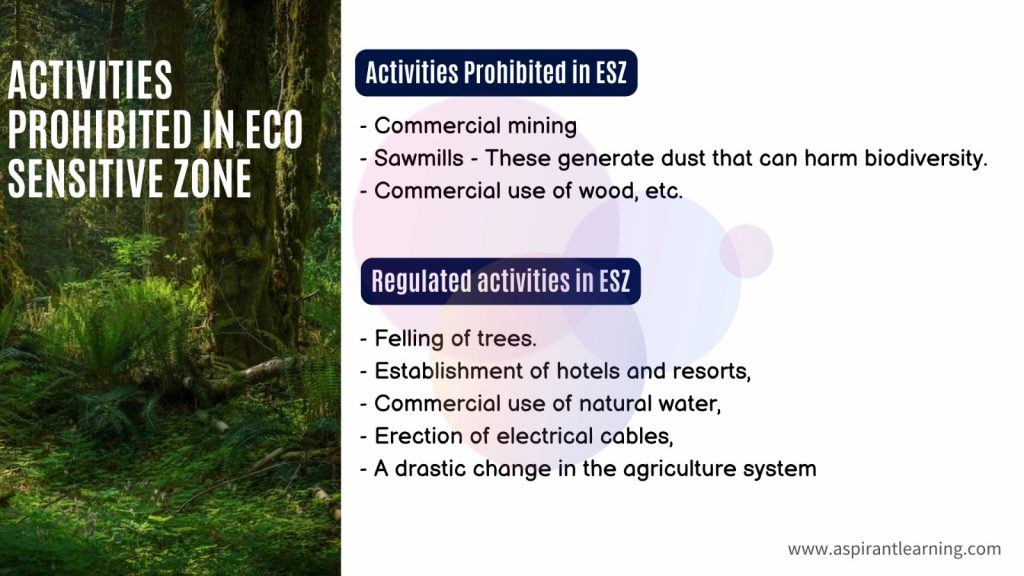News Highlight
Supreme Court modifies judgement on eco-sensitive zones around protected forests.
Key Takeaway
- The Supreme Court updated its ruling to requiring mandatory eco-sensitive zones (ESZ) of at least one km surrounding protected forests, national parks, and wildlife sanctuaries throughout the country.
- According to a Bench by Justice B.R. Gavai, ESZ cannot be consistent across the country and must be “protected area-specific.”
- The Supreme Court ordered the 1-kilometre buffer zone for protected areas to operate as a “shock absorber” on June 3, 2022.
- However, the Centre and many states, including Kerala, have petitioned the Supreme Court to modify the June 2022 judgement.
- It claimed that the judicial direction damaged hundreds of villages on the outskirts of forests.
Eco-Sensitive Zones
- About
- Ecologically Fragile Areas (EFAs) are another name for Eco-Sensitive Zones (ESZs).
- The MoEFCC has designated eco-sensitive zones around Protected Areas, National Parks, and Wildlife Sanctuaries.
- Declining ESZs aims to create “shock absorbers” for protected areas by regulating and supervising activities in and around them.
- According to the National Board for Wildlife, eco-sensitive zones must be site-specific.
- Unless otherwise necessary, the activities should be regulatory rather than restrictive.
- The primary goal is to regulate certain activities in and near National Parks and Wildlife Refuges.
- Its purpose is to reduce the detrimental effects of such activities on the fragile environment surrounding the protected areas.
- They also serve as a transition zone between areas of high protection and areas of lower protection.
Significance of ESZs
- Minimise the Impact of Development Activities
- The areas close to protected areas have been designated as Eco-Sensitive Zones.
- It reduces the impact of urbanisation and other development activities.
- In-situ Conservation
- ESZs contribute to in-situ conservation, concerned with preserving an endangered species in its natural habitat.
- For example, protecting the One-horned Rhino in Assam’s Kaziranga National Park.
- Minimise Forest Depletion and Man-Animal Conflict
- Eco-Sensitive Zones reduce deforestation and human-animal conflict.
- The protected areas are managed using the core and buffer strategy, which protects and benefits local communities.
- Minimise the Negative Impact on Fragile Ecosystems
- Establishing eco-sensitive zones around protected areas aims to act as a ‘Shock Absorber‘ for the protected region.
- They also serve as a transition zone between areas of high protection and areas of lower protection.
Challenges Associated with ESZs
- Climate change
- Climate change has increased the ESZs’ land, water, and ecological stress.
- For example, recurrent forest fires and Assam floods have wreaked havoc on the Kaziranga National Park and its animals.
- Encroachment of Forest Rights
- Sometimes, the implementation of the Environmental Protection Act of 1986.
- The Wildlife Protection Act of 1972 causes authorities to disregard forest communities’ rights, affecting their livelihoods.
- It also involves weakening the rights granted to the gramme sabha for development clearances.
- The Forest Rights Act of 2006 required the recognition of forest rights and the agreement of the gramme sabha before evaluating projects.
- It aims to divert forest land for non-forestry purposes until the MoEFCC abolishes them in 2022.

Way Forward
- Community Engagement
- Including local communities in the decision-making process for ESZ administration is critical.
- This can be accomplished by forming community-based organisations, such as user groups or conservation committees, to manage and safeguard the resources found in these locations.
- Regarding development initiatives, the Gramme Sabha must be given decision-making powers.
- Alternate Livelihood support
- It is critical to provide alternative livelihood opportunities for local communities that rely on the resources available in ESZs for survival.
- Training programmes and financial assistance for alternative livelihoods such as eco-tourism, horticulture, and sustainable agriculture can be included.
- Promoting Eco Restoration
- It is necessary to reforest and reforest damaged forests, regenerate lost habitats, and reduce climate change impacts by promoting carbon footprints via education.
Pic Courtesy: Journals of India
Content Source: The Hindu



